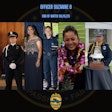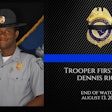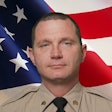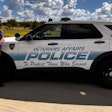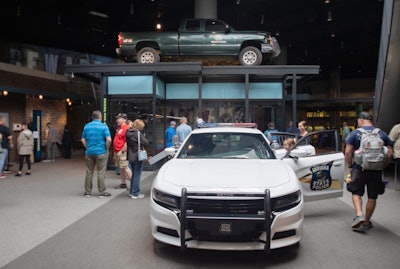 The National Law Enforcement Museum in Washington, D.C., tells the story of American law enforcement and contains many significant historical items on exhibit.PHOTO: National Law Enforcement Museum
The National Law Enforcement Museum in Washington, D.C., tells the story of American law enforcement and contains many significant historical items on exhibit.PHOTO: National Law Enforcement Museum
During a time when COVID slowed visits to many attractions, leadership at the National Law Enforcement Museum worked to remove some exhibits and modify others. While it is still dedicated to telling the story of American law enforcement by providing visitors a “walk in the shoes” experience, the priority now is to honor officers rather than just sharing the history.
“This has been built for them, we exist for them. We exist to honor the story of American law enforcement. That's why when I get in front of some of these larger groups of law enforcement officers, I open my arms to the need for them to come visit,” says Marcia Ferranto, National Law Enforcement Officers Memorial Fund (NLEOMF) CEO. “Because during today's times, do we need a law enforcement museum that's honoring law enforcement? You bet we do.”
When the 57,000-square-foot museum opened in October 2018, the purpose was to be a law enforcement history museum says Ferranto. She said the initial exhibits told the story of the history of law enforcement but not from the angle of honoring law enforcement. That has changed.
The museum was closed due to COVID from March 2020 through mid-August 2001 and that allowed time to refine the exhibits to better honor police. The museum is one of the three pillars of NLEOMF with the other two being The National Law Enforcement Officers Memorial and the Officer Safety and Wellness programs.
“The board of directors decided that we exist to honor law enforcement. So, we went through the museum, and we removed anything that did not have to do with honoring law enforcement,” she says. “Any label, any exhibit that did not directly honor professional law enforcement was either edited or removed.”
She points to an exhibit, now a former exhibit, about police corruption. It did not honor police, so it was removed. “So now when law enforcement come into the building, they feel the honor in which the building was meant to be to them,” she says.
In addition to officers visiting and bringing family along, Ferranto sees value in the general public visiting the museum as well. Those visitors can learn what it is like to be a police officer in America.
“Our museum is an experience. There are many museums in Washington, DC, and I will tell you, ours is probably the most interactive museum. So, the public needs to know that not only will you learn something coming to the museum, learn a lot about law enforcement, but you will also be entertained by the activities in the museum that help you learn in a different way,” she says. “They will learn about walking in the shoes of a law enforcement officer, and maybe get a different view on what these law enforcement officers do on a daily basis and also maybe understand a little bit more about what it takes to be a law enforcement officer.”
Simulators
Two simulators are the showpieces of the interactive experience at the museum. One is a use-of-force training simulator where participants make shoot or no-shoot choices and the other is a driving simulator.
The InVeris decision making simulator provides visitors with a “walk in the shoes” experience of a law enforcement officer. During this experience, visitors will interact with a use-of-force simulation based on real situations officers face in their communities. The experience helps them better understand the weight of split-second decision making and the intricacies of escalation and de-escalation of force practices. Two guests are put in scenarios that are run by professional law enforcement officers and the participants must quickly make a decision to shoot or not shoot as they watch events unfold on the screen. Ferranto says it is a learning experience for not just the participants but for the audience of typically 15 to 20 as well.
“There's great discussion that goes on about what just happened. How did the person respond? Could they have done it differently? What did they not see that a law enforcement officer would see? So that's a great experience,” says Ferranto. “It is a time to really pay attention to what these men and women are up against every day.”
The goal of the museum’s other simulator, an L3Harris PatrolSim, is to give visitors an opportunity to experience the reality faced by a law enforcement officer behind the wheel. As part of the experience, visitors will view a specific set of scenarios to best illustrate the split-second decision-making required of law enforcement officers. Each driving experience will be guided by veteran officer instructors who have trained active officers on the same systems.
“People sometimes, because it's so real, actually have a hard time getting up out of the chair,” Ferranto says. “It's one of the highlights of the museum. Both simulators are just awesome experiences.”
Expert Guides
One of the best recent changes at the museum, according to Ferranto, is the creation of a guide program. The guides are current and former law enforcement officers who volunteer. Currently there are seven to 10 guides trained but soon the group will develop into about 20. Advanced guides will be on hand to tour members of Congress and other key visitors, Ferranto says. At the other end of the spectrum will be the newer guides in training. If guests choose not to use a guide, they can still take a self-guided tour of the museum.
“We can put real law enforcement officers as guides in the museum to help enhance the experience of the visitor and that is working extremely well. We have some incredible officers who just love walking people around and sharing the story about law enforcement,” Ferranto says. “The vision is to have guides on the floor during our heavy traffic times to either answer questions at certain areas in the museum or to do or to do individual tours, which a family member would pay extra money for.”
Free Saturdays
While the typical admission fee is less than $20, officers will be admitted for free every Saturday through the end of the year compliments of FirstNet Built with AT&T, which is sponsoring the free day for cops, both active and retired. Current officers, retired officers, and survivors all receive discounted admission on the other days the museum is open. First-year survivors are admitted free on any day.
Currently the museum will be open to the public three days a week – Thursday (beginning in July), Friday, and Saturday. However, groups can plan visits on the other days with the exception of Mondays and Tuesdays when the museum is closed for maintenance. Ferranto says it is hard to compare this year’s attendance to last year’s because of COVID, but compared to 2020 this year’s two-day attendance appears to be good.
“We're doing pretty well if you compare our Fridays and Saturdays in 2020 to what we are today we're doubled,” she said. “I think it’s because we are doing better.”
Ferranto hopes officers and the general public will visit the museum throughout the year, however the busiest time of year is always during National Police Week since the museum is a short walking distance from The National Law Enforcement Officers Memorial.
“What happens is they're drawn to the memorial, of course, and we have enough signage and we have had enough publicity that the museum is a magnet. So, they get over there and then they head over to the museum,” Ferranto says. “We have had incredible feedback from National Police Week, from law enforcement officers from all around the country, recognizing that when they step on this campus they do feel honored, they do feel that this is a home for them, a place of comfort. So, I think we're doing it right.”
Exhibits and Artifacts
Guests should allow plenty of time to visit the museum since the collection of more than 25,000 objects tells the story of American law enforcement – past, present, and future. Some of the more unique items to see include:
- Eliot Ness Credentials — Credentials belonging to US Treasury Special Agent Eliot Ness who is best known for his “untouchable” agents who refused to be bribed or blackmailed during prohibition and the hunt for notorious mobster Al Capone. Ness was responsible for eventually arresting Capone and bringing an end to his operation.
- Hoover Desk — The desk and furniture belonging to FBI founder J. Edgar Hoover. The National Law Enforcement Museum is responsible for the care and keeping of the entirety of the J. Edgar Hoover Foundation collection.
- Robert Kennedy Items — A briefcase, ashtray, nameplate, and eyeglasses belonging to former Attorney General Robert F. Kennedy who was assassinated on June 5, 1968, five years after the assassination of his brother, President John F. Kennedy. These items are on loan to the museum from the John F. Kennedy Library.
- Eagle One — The Eagle One helicopter that saved five people from the cold, icy Potomac River after the crash of Air Florida Flight 90 in 1982. To learn more about the crash and the Park Police Aviation Unit visit the museum’s online exhibit; Eyes to the Sky: A Century of Law Enforcement Aviation and Airborne Public Safety.
 The Museum shares the story of law enforcement aviation and the Eagle One helicopter that saved five people from the Potomac River after the crash of Air Florida Flight 90 in 1982 is on display.PHOTO: National Law Enforcement Museum
The Museum shares the story of law enforcement aviation and the Eagle One helicopter that saved five people from the Potomac River after the crash of Air Florida Flight 90 in 1982 is on display.PHOTO: National Law Enforcement Museum
- RoboCop 2 Costume — Costume from the movie RoboCop 2 worn by Peter Weller. In the film, set in a dystopian Detroit, RoboCop becomes embroiled in a scheme made by Omni Consumer Products to bankrupt and take over the city while also fighting the spread of a street drug and its gang of dealers.
- Block from Pentagon on 9/11 — On loan from the Newseum, this block was recovered after the terrorist attacks on Sept. 11, 2001, from the Pentagon. It weighs 6,300 pounds and currently sits outside the entrance to the museum’s newest changing exhibit, Post 9/11: The Evolution of American Law Enforcement.
- Capone Bulletproof Vest — Bulletproof vest worn by notorious bootlegger and gangster Al Capone. The navy-blue vest has vinyl covered lead inserts on the back and front to keep the wearer safe from gunfire.
- Journal of Detective Tom Lang — This journal belongs to Detective Tom Lang of the LAPD. Lang was an investigating officer during the OJ Simpson case and includes extremely detailed notes. A new forensic technique, using DNA evidence, was introduced to the public during this highly publicized trial.
- K9 Statue — A statue of Dux the police dog and a life‐cast of his partner Deputy Kelley. In October 2016, Dux was injured when he was shot by a man fleeing a traffic stop. Dux made a full recovery. A year after being injured, the Virginia General Assembly honored Dux for his heroic actions to protect his fellow officers. The two partners were placed side by side in the museum, much like they were on the job at Spotsylvania Sheriff's Office.
- Sons of Silence Motorcycle — The motorcycle used by Special Agent Blake Boteler during his time undercover with the Sons of Silence motorcycle club who were suspected of illegal possession and sales of firearms and narcotics. Boteler spent two years undercover with the club and his efforts resulted in 51 arrests, the retrieval of more than 75 firearms, and the recovery of more than 10 pounds of methamphetamine ($250,000 in estimated street value).
- Drunk‐o‐Meter — Before the modern breathalyzer tests, which weren’t developed until 1954, officers used a large “Drunk‐o‐meter" kit to determine whether an individual had been drinking and driving. The kit contains several vials of different chemicals that an officer would use to determine a suspect's blood alcohol level.
- 911 Phone — Small red phone that received the first ever 911 call. The phone rang in Haleyville, AL, on Feb. 16, 1968. Alabama had an independent phone company that beat out the major telephone giants in the race to set up the new national emergency number.
- ATF Radio — Motorola radio walkie talkie used during the Bureau of Alcohol, Tobacco, Firearms and Explosives raid of the Branch Davidian compound in Waco, TX, in 1993. This radio was used by Assistant Special Agent in Charge Gary Orchowski and was significantly damaged by gunfire at that time. Later, it was collected as evidence by the ATF and still has several evidence stickers.
- The Hall of Remembrance — The room features the names and photographs of officers added to the National Law Enforcement Officers Memorial each year. Visitors can also learn about the founding of the memorial, National Police Week, and the ongoing effort to honor the fallen.
- Service and Sacrifice — The film plays for all visitors at the top of every hour in the Verizon Theater. It is a film experience that explores the soul and purpose of law enforcement officers and their families. The film demonstrates what drives someone to become a police officer, what motivates them in their work, the obstacles they face, and how their families and loved ones feel about and are affected by what they do and the risks they take.
 The Hall of Remembrance features the names and photographs of officers added to the National Law Enforcement Officers Memorial each year.PHOTO: National Law Enforcement Museum
The Hall of Remembrance features the names and photographs of officers added to the National Law Enforcement Officers Memorial each year.PHOTO: National Law Enforcement Museum










